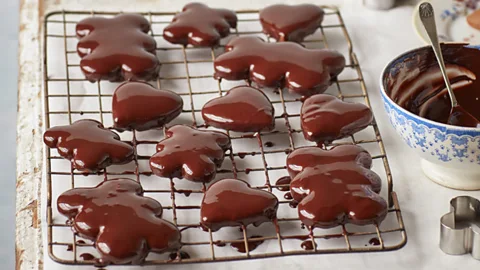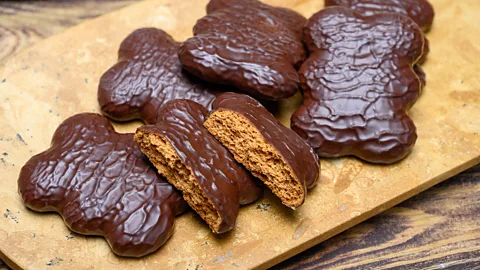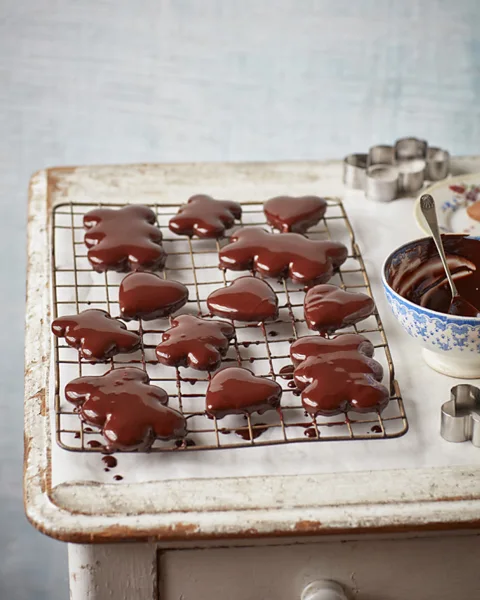Katarzynki: Poland’s famous gingerbread from Torun
 Nassima Rothaker
Nassima RothakerAlthough the recipe is usually kept secret, Ren Behan, author of Sweet Polish Kitchen, has found a way to make Polish gingerbread biscuits from the town of Torun at home.
The Polish city of Toruń is famous for being the birthplace of Nikolaus Copernicus – also known as Kopernik – the astronomer who, as we say in Poland, "stopped the Sun, and moved the Earth". But Kopernik is also the name of a company producing the town's famous Toruńskie pierniczki (Toruń gingerbread), which is celebrating its 260th anniversary this year.
Many Polish sweets are named after people (a chocolate bar called Grzesiek, or Greg, is a great example), and a type of Toruń gingerbread called katarzynki is no exception. These spiced biscuits, which are covered in chocolate and shaped like a cloud, were most likely named after Katherine of Alexandria, a 4th-Century saint and martyr who is honoured in the Orthodox and Catholic church on 25 November. In Poland, "Katarzynki Day" is often celebrated by young men who wish to get married and is devoted to fortune telling and divination rituals to reveal the name of their future wives. (Women have "Andrzejki Day", or St Andrew's Day, on 30 November.)
25 November is the day Toruń bakers typically start preparing the dough for the Christmas biscuits. The ingredients include honey, sugar, flour, egg and spices like cinnamon, cloves and allspice; not necessarily ginger. While these treats have "ginger" in their English name, their Polish name, pierniczki, stems from pierny, an old Polish word meaning "peppery".
According to the Gingerbread Museum in Toruń, gingerbread dates to as early as 1380. A predecessor of pierniczki was already produced in the Roman Empire and then spread to other places in Europe – including The Netherlands, and the Czech Republic – during Medieval times. Toruń became famous for its gingerbread, originally brought to the city by Germans, due to its location at the crossing point of various European trading routes and its hip in the Hanseatic League, which introduced the city to the spices.
Wedding gingerbread
Pierniczki (gingerbread) dough used to be prepared in families when a baby girl was born. It would mature for years before being rolled out, cut and baked on her wedding day.
The diminutive form separates pierniczki (gingerbread biscuits) from piernik (gingerbread cake). But according to writer and cookbook author Ren Behan, katarzynki tend to be something in between the two, texture-wise: "It's really about wanting something that's not quite a biscuit and not quite cake, but something in the middle that has some softness in it," she said.
Behan was born in the UK to Polish parents and feels very grounded in Polish culture. "It's one of the things I used to eat as a child when we would go to the Polish Combatants' Club [Polski Dom Kombatanta w in Manchester]. Behind the bar they always had packets of katarzynki. I very much the noise that the packet made and sinking my teeth into that first chocolate and then that lovely gingerbread," she said.
The recipe for Toruń gingerbread was often only ed down orally. Kopernik, the largest and most famous producer of Toruń gingerbread keeps their recipe a carefully guarded secret. They have ed the name "katarzynki" to refer to their cloud-shaped version. However, Behan has found a way to make katarzynki at home.
"You've got runny honey, sugar, butter. I use rye flour, cinnamon, cloves, allspice, and then a little bit of cocoa powder just for the flavour, and that nice darkness when it bakes. And then just good quality chocolate poured over the top."
Behan had the typical cloud-shaped biscuit cutter shipped over from Poland. But home chefs aiming for the traditional look should not despair if they don't have one.
 barmalini/Getty Images
barmalini/Getty ImagesLegend has it that a Toruń baker fell sick one day and asked his daughter Katarzyna to make his famous biscuits. Because she didn't have a biscuit cutter, she cut out circles of dough with a glass. But when they baked in the oven, the rounds ran together to create a new, cloud-like shape. To achieve the same look, home bakers can use a small biscuit cutter to cut out circles and lay them close together in groups of six.
Behan started her blog in 2010, first to share the seasonally inspired recipes she made for her family, then to bring Polish food to an English-speaking audience.
Her first cookbook, Wild Honey and Rye was published in 2017 to great acclaim and offered a fresh, modern look at Polish cuisine. But her newly published cookbook, Sweet Polish Kitchen (available in the US on 5 December and in the UK on 29 February), is inspired by European cafe culture, which in turn has been influenced by ingredients and techniques from all over the world, including from , Italy, Switzerland and . Its focus is to "to explore this world of Polish baking and Polish sweet goods, and then hopefully to inspire people," Behan said.
And as for gingerbread, she added, "it's a flavour everybody knows."
 Nassima Rothaker
Nassima RothakerMakes 20
Ingredients
200g runny honey
100g soft dark brown sugar
100g butter, at room temperature
100g white rye flour
300g plain flour, plus extra for dusting
1 tsp baking powder
1 tsp bicarbonate of soda
2 tsp ground cinnamon
1 tsp ground cloves
1 tsp ground allspice
2 tsp cocoa powder
2 egg yolks
400g good-quality dark chocolate, melted
Method
Step 1
Put the honey, sugar and butter into a small pan, whisk together and heat gently until melted. Set aside.
Step 2
Combine the dry ingredients in a large bowl, along with the egg yolks. Mix, then pour in the melted liquid honey mix. Keep mixing until a dough forms. Cover with clingfilm and chill in the refrigerator for 1 hour.
Step 3
Preheat your oven to 180C/160C Fan/Gas Mark 4/350F. Line a baking sheet with baking paper.
Step 4
Sprinkle a little flour on a board and roll out the dough (it's easier if you roll it between two sheets of baking paper). Using a biscuit cutter, cut into shapes and place them carefully onto the lined baking sheet, leaving at least 1cm between each biscuit.
Step 5
Bake (in batches if needed) for 20 minutes, or until the biscuits are light golden. They will puff up slightly and harden. They need to soften a little, so cool completely on a wire rack, then transfer them to a tin to mature for 2 weeks, before coating with chocolate.
Step 6
To coat, place the biscuits on a wire rack and spoon the melted chocolate over them once dry, store them in a tin.
BBC.com's World's Table "smashes the kitchen ceiling" by changing the way the world thinks about food, through the past, present and future.
---
